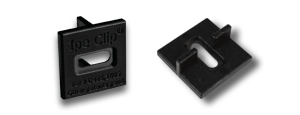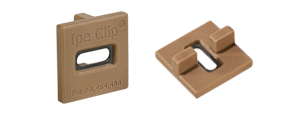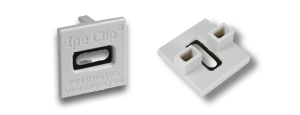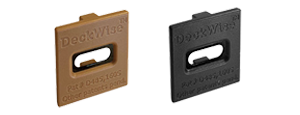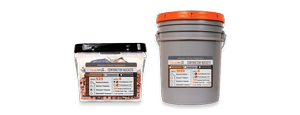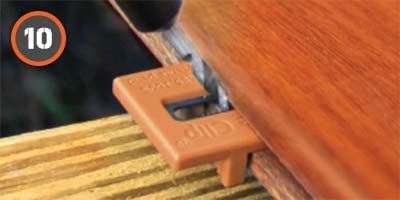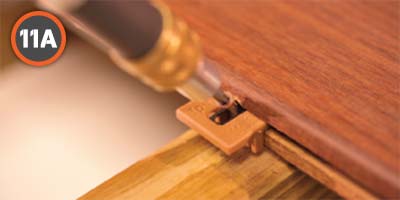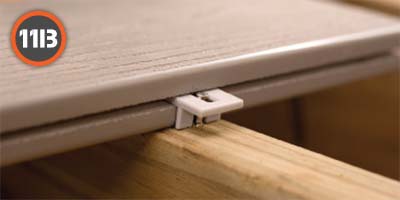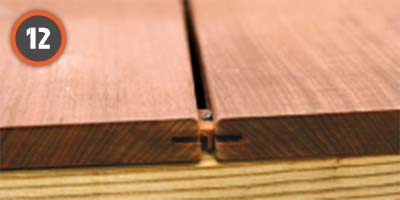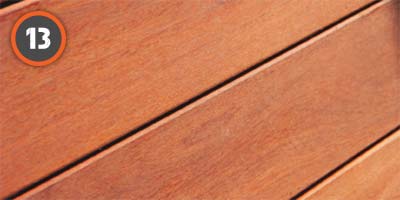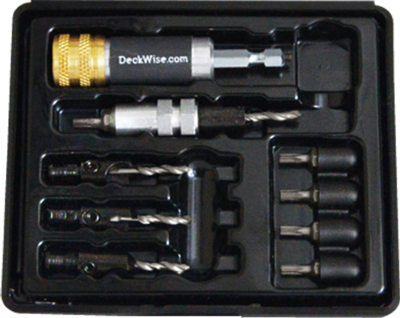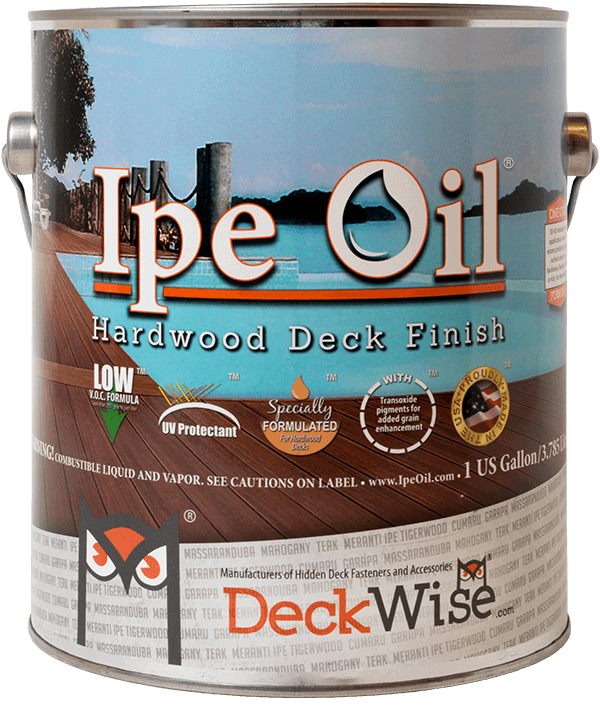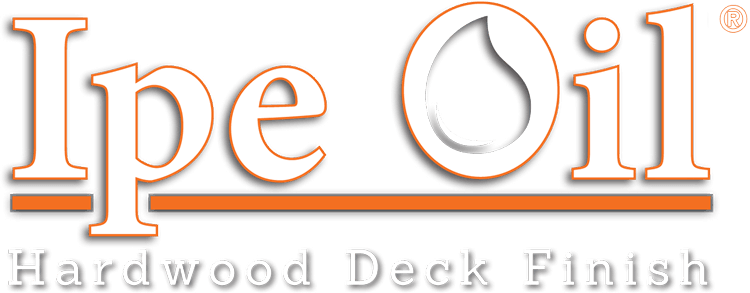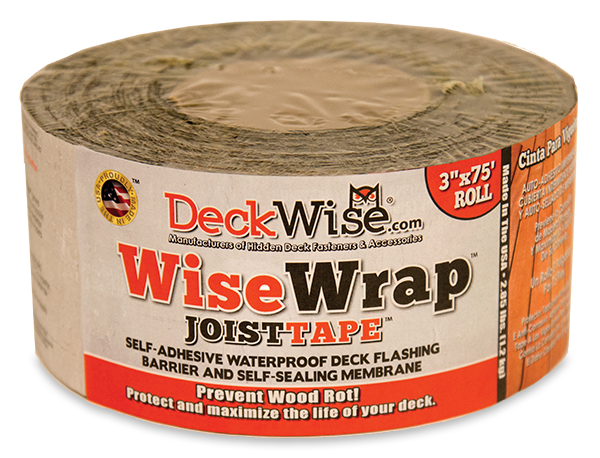
Step 1: Installing the First Deck Board
Apply DeckWise® JoistTape™ or a bead of exterior adhesive to each joist approximately 3/8 " in width. For adhesives, you may want to do this
as you go so, that, it does not dry before completion if you have a larger area to install. While adhesive adds hold-down strength to the boards, it does not prevent wood rot. JoistTape™ prevents joist
wood rot as well as seals around deck screws.Even though joists may seem even, changes in weather can cause board movement. Both JoistTape™ and/or adhesive will also help prevent squeaking from uneven
joists in the future.
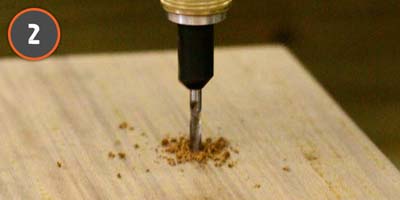
Step 2: Drill a 1/8" pilot Hole
Use a 1/8 " drill bit to pre-drill a pilot hole for the initial face- driven screws. Drill deep enough to penetrate the deck board and NOT the underlying joist material.
(All Ipe Clip® Hidden
Deck Fastener systems, 175 count and above, include a 1/8 " High Speed Drill Bit. We suggest using the 3-in-1 DeckWise® Drill & Drive™
(not included in Ipe Clip® Fastener kits), which has a 1/8 " drill bit, 3/8 " countersink bit, and screw gun T15 tip that will help speed up this process.)
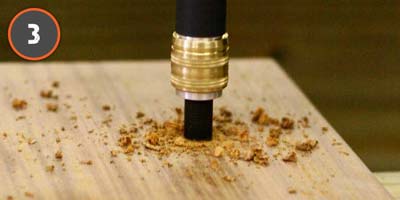
Step 3: Drill a 3/8" countersink hole approximately 3/8" deep
Use a 3/8 " countersink bit to bore a hole approximately 1/4 " to 3/8 " deep (depending on your deck board thickness) for each screw to be hidden by a hardwood plug. Be sure your countersink bit is
sharp and leaves a clean edge.
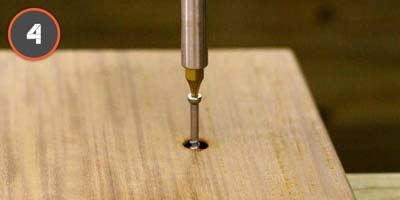
Step 4: Drive a deck screw through the countersunk hole
Next, securely drive a deck screw down into the countersunk hole into the joist below. (All Ipe Clip® fastener kits, 175 count and above, have extra stainless steel deck screws included in
them for starter boards.) Wood plugs will next be installed into the holes to hide the deck screws and create a smooth, blemish free surface.
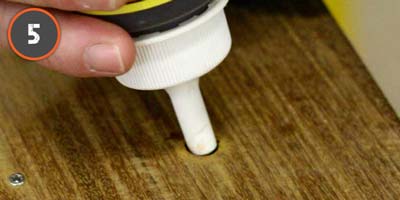
Step 5: Put a drop of glue in the countersunk hole
Place a dab of wood glue (Gorilla Glue® is suggested) into the countersink hole from the above steps. This will secure the wood plug from
popping up in the future. Plus, it will act as a moisture barrier, sealing the countersunk hole and screw.
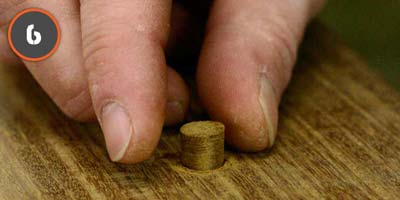
Step 6: Insert a wood plug into countersunk hole
Insert a 3/8 " tapered (or Extreme ribbed) Hardwood Plug and tap it down with a hammer so it fits snug into the hole. Wipe away any excess glue that may squeeze
out. NOTE: We always encourage finding the wood grain in the plug and aligning it with the deck board grain. This will help ensure the plug is hidden as much as possible.
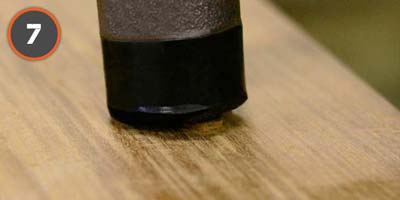
Step 7: Flush cut any plug material
Once the plug is hammered in and the glue is dry, remove any excess plug material protruding above the surface of the deck board. You can accomplish this by using a flush cut pull saw, belt sander or
an orbital sander with 80 grit sand paper.
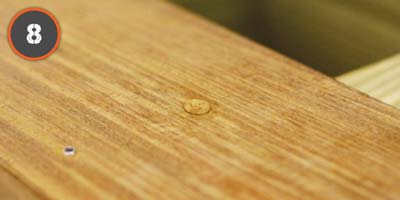
Step 8: Sand for hardwood oil finish
Sand smooth all areas where a plug was installed so that plug is flush with deck surface. A round, random orbit sander with 80-120 grit sand paper works best. When sanding is finished, we suggest
using Ipe Oil® for a beautiful natural wood color on your entire deck
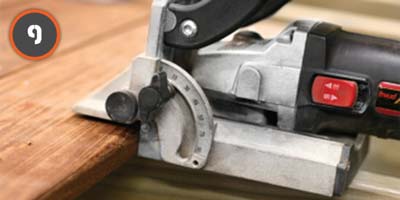
Step 9: cut slots for Ipe Clip® Fasteners
Use a biscuit jointer or a router (with a 5/32 " X 1/2 " slot cutting bit) to cut a slot in the edge of deck board above each joist. You will want to center this groove in the board so there is a
symmetrical profile for best results using the Ipe Clip® Hidden Deck Fasteners by DeckWise® .
NOTE: pre-grooved deck boards are now available from many decking suppliers. If you are using pre-grooved decking, skip this step and proceed to step 10.
Step 1: Installing the First Deck Board
Apply DeckWise® JoistTape™ or a bead of exterior adhesive to each joist approximately 3/8 " in width. For adhesives, you may want to do this
as you go so, that, it does not dry before completion if you have a larger area to install. While adhesive adds hold-down strength to the boards, it does not prevent wood rot. JoistTape™ prevents joist wood
rot as well as seals around deck screws.Even though joists may seem even, changes in weather can cause board movement. Both JoistTape™ and/or adhesive will also help prevent squeaking from uneven joists in
the future.
Step 2: Drill a 1/8" pilot Hole
Use a 1/8 " drill bit to pre-drill a pilot hole for the initial face- driven screws. Drill deep enough to penetrate the deck board and NOT the underlying joist material.
(All Ipe Clip® Hidden
Deck Fastener systems, 175 count and above, include a 1/8 " High Speed Drill Bit. We suggest using the 3-in-1 DeckWise® Drill & Drive™
(not included in Ipe Clip® Fastener kits), which has a 1/8 " drill bit, 3/8 " countersink bit, and screw gun T15 tip that will help speed up this process.)
Step 3: Drill a 3/8" countersink hole approximately 3/8" deep
Use a 3/8 " countersink bit to bore a hole approximately 1/4 " to 3/8 " deep (depending on your deck board thickness) for each screw to be hidden by a hardwood plug. Be sure your countersink bit is sharp
and leaves a clean edge.
Step 4: Drive a deck screw through the countersunk hole
Next, securely drive a deck screw down into the countersunk hole into the joist below. (All Ipe Clip® fastener kits, 175 count and above, have extra stainless steel deck screws included in them
for starter boards.) Wood plugs will next be installed into the holes to hide the deck screws and create a smooth, blemish free surface.
Step 5: Put a drop of glue in the countersunk hole
Place a dab of wood glue (Gorilla Glue® is suggested) into the countersink hole from the above steps. This will secure the wood plug from popping up
in the future. Plus, it will act as a moisture barrier, sealing the countersunk hole and screw.
Step 6: Insert a wood plug into countersunk hole
Insert a 3/8 " tapered (or Extreme ribbed) Hardwood Plug and tap it down with a hammer so it fits snug into the hole. Wipe away any excess glue that may squeeze out.
NOTE: We always encourage finding the wood grain in the plug and aligning it with the deck board grain. This will help ensure the plug is hidden as much as possible.
Step 7: Flush cut any plug material
Once the plug is hammered in and the glue is dry, remove any excess plug material protruding above the surface of the deck board. You can accomplish this by using a flush cut pull saw, belt sander or an
orbital sander with 80 grit sand paper.
Step 8: Sand for hardwood oil finish
Sand smooth all areas where a plug was installed so that plug is flush with deck surface. A round, random orbit sander with 80-120 grit sand paper works best. When sanding is finished, we suggest using
Ipe Oil® for a beautiful natural wood color on your entire deck
Step 9: cut slots for Ipe Clip® Fasteners
Use a biscuit jointer or a router (with a 5/32 " X 1/2 " slot cutting bit) to cut a slot in the edge of deck board above each joist. You will want to center this groove in the board so there is a
symmetrical profile for best results using the Ipe Clip® Hidden Deck Fasteners by DeckWise®.
NOTE: pre-grooved deck boards are now available from many decking suppliers. If you are using pre-grooved decking, skip this step and proceed to step 10.

